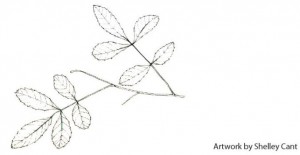COMMON NAMES
Brazilian peppertree, Peruvian peppertree, California peppertree, mastic-tree, American pepper, false pepper, Christmas berry and Florida Holly.
HISTORY OF INTRODUCTION
The Brazilian pepper originated from the South America countries, Paraguay, Argentina and Brazil. It was introduced into the United States as an ornamental plant around the mid to late 1800’s. However, it had not spread into natural areas until the 1950’s but is now considered the dominant plant in many parts of Florida. Much like Florida, the plant was brought to the Bahamas also for ornamental purposes and has replaced countless native plants in many areas due to its invasive characteristics.
DESCRIPTION
The Brazilian pepper is a tall shrub with multiple trunks and can grow up to about 40 feet tall. The leaflets are usually a deep glossy green color with reddish veins that grow opposite from each other with one leaflet at the tip. The leaflets can have a serrated or smooth edge and are aromatic, meaning that they produce a distinctive smell when crushed. This smell is spicy in nature lending the plants its name. The clustered flowers are small and ivory white in color. They produce bright red berries which is its main attraction.
HABITAT
The Brazilian pepper is sensitive to cold temperatures and so tends to grow in tropical to sub-tropical environments. It grows in any recently disturbed area for development but it also frequents Pine Forests, Mangrove and Coastal areas which has made it a pest because these ecosystems are home to many native flora.
DISTRIBUTION
Brazilian pepper can now be found not only in Florida and the Bahamas but also in the West Indies, Hawaii, California, North and South Africa.
REPRODUCTION
The fruits of the Brazilian pepper tree usually mature in December. The seedlings have a high survival rate and can be found all year round. These seeds are mainly dispersed by birds who eat the narcotic berries only to spit them out spreading the seeds and saliva which acts as a fertilizer. The roots can also reproduce asexually by sending up shoots.
CONSERVATION CONCERNS
This fast growing species is a successful invader due mainly to the effective way its seeds are dispersed. Apart from help from birds, it has spreading low branches that create an immense intertwining tangle that makes it almost indestructible by man, insects and even natural disasters. At the same time it allows very little light in for native coppice threatening their existence. Due to these adaptations, Brazilian pepper has not only out-competing the native trees but it is also destroying food sources for native animal species such as birds.
INTERESTING FACTS
The Brazilian Pepper belongs to the same family as the Poison Wood with all parts of the plant containing irritating compounds which produce allergic reactions particularly on the skin. When the berries are ingested in large amounts they can cause a host of different complications from inflammation, vomiting and diarrhea, hemorrhoids, shortness of breath and violent headaches. However, the plant has also been used in the past for medicinal purposes. In the Bahamas, Brazilian Pepper is also called the Christmas Holly. The Brazilian Pepper produces a lot of nectar when it blossoms and therefore has been favored by Bee Keepers. However, this small benefit is far out-weighed by the negative aspects of this plant.
